Impacts of Climate Change on Rural Women Households and their Adaptation Strategies: Halaba District, Ethiopia
Tesemash Abebe1* and Leta Bekele2
1 Department of Climate Science, Ethiopian Environment and Forest Research Institute, Ethiopia
2 Department of Meteorological Data and Climatology, Ethiopia Meteorology Institute, Ethiopia
Submission: March 09, 2022; Published: May 09, 2022
*Corresponding author: Tesemash Abebe, Department of Climate Science, Ethiopian Environment and Forest Research Institute, Addis Ababa, Ethiopia
How to cite this article: Tesemash A, Leta B. Impacts of Climate Change on Rural Women Households and their Adaptation Strategies: Halaba District, Ethiopia. Int J Environ Sci Nat Res. 2022; 30(2): 556285. DOI: 10.19080/IJESNR.2022.30.556285
Abstract
Women are most vulnerable to climate change-related hazards based on their dependence on natural resources, daily life roles, and socioeconomic status. This study investigated the impact of climate change on rural women's households and their adaptation strategies. Purposive and systematic random sampling methods were used to select samples from the district, kebeles, and household heads. Four kebeles were selected purposively, and 200 female and male-headed households, 100 of each sex, were selected using systematic random sampling techniques. Primary data were collected through a household survey, focus group discussions, and interviews with key informants. The data were analyzed using both qualitative and quantitative methods (descriptive statistics and multinomial logit models). The results of this study show that female-headed households appear to be the most vulnerable segment of the community to the impacts of climate change due to existing gender-biased relations; limited access and less control over key resources, and the unfair distribution of roles, resources, and power. The major adaptation strategies to climate change are crop diversification, income source diversification, soil and water conservation, and irrigation. Generally, female-headed households appear to be more vulnerable to the impacts of climate change than male-headed households. Therefore, this study recommends the need to enhance women-headed households' capacity for effective adaptation by devising gender-responsive interventions. Moreover, it is important to strengthen the quality and delivery of important resources and services with increased efforts to ensure the participation of women to benefit them.
Keywords: Climate change impacts; Gender based vulnerability; Women household
Introduction
Climate change has the power to affect all living things on earth. It affects all parts of the world in multifaceted ways, such as drought, flood, melting of ice belts, and rise in sea level [1,2]. The impacts of climate change are much more serious in developing nations than in developed nations, because they are less able to prepare for, respond to, and cope with the adverse effects of climate change and variability [3-5]. In developing nations, women are most vulnerable to the impact of climate change and variability [5], [6]. However, this is not a gender-neutral phenomenon. However, because the poorest people are the most affected by climate change, women make up the disproportionate majority of the world poor, and because their role is primarily in household food security, they are the most vulnerable [5,7,8]. Of the 1.3 billion people in the developing world living below the poverty line, 70% are women [2]. African rural women are highly dependent on natural resources such as forests, rivers, and land for their daily livelihood, which is more secretive to climate change [9].
Deeply rooted in patriarchal values and beliefs, rural women do not have equal rights to crucial resources, decision and policy-making forums, institutions that govern them. On the other hand, women's vulnerability to climate change can be observed by looking at their daily lives [10,11]. Women spend most of their time on agriculture-related activities, contributing to lower level farming, which accounts for more than 50% of the labor working on farms [5,8]. They perform the roles of finding, collecting, carrying, storing, securing, purifying, and distributing water and food for various household purposes, such as drinking, cleaning, washing, sanitation, feeding families, production of livestock and crops; cutting and carrying fuel such as agricultural waste or wood for heating homes, drying clothes, and cooking; cutting and learning about herbs to treat diseases and taking care of the elderly and sick [7,12]. To accomplish daily activities and responsibilities, they are directly or indirectly related to the natural environment. This natural environment changes over time as a result of climate change and variability. Additionally, women's vulnerabilities increase because of less ownership of assets, high levels of illiteracy, low social status, limited mobility, socially formed barriers to dependence on males, unequal access to resources, and less involvement in decision-making processes [2,6,13]. This also affects the capacity of women to adapt to the impacts of climate change and variability, but they are also most capable of creating change and adaptation within their communities [5,10]. Women are involved in afforestation, crop domestication, soil and water conservation, and so on [10]. Therefore, this study was designed to investigate the impacts of climate change and variability on rural women and their adaptation strategies and thereby suggest adaptation strategies that can improve the adaptation capacity of women in the area.
Methodology
Description of the study area
The Halaba district is located between 7° 10’N and 7o 42’N latitude and 38° 00’E and 38o 25’E longitude in southeastern Ethiopia (Figure 1). The area is located approximately 315km south of Addis Ababa and 85km south-west of Hawassa, the capital of the Southern Nations Nationalities and Peoples Regional State and Sidama region. The total area of the district is 973.7Sq.Km, with 70% flat, 27% sloped, and 3% mountainous. The altitude ranges in the area from 1700 to 2200m above sea level. The administrative center is Halaba-Kulito. The administrative center is Halaba-Kulito. The population in the 2006 E.C (2013G.C) was estimated to be 305,555, of which 151,101 (49%) were men and 154,454 (51%) were women. The urban population accounts for 37,303 while the rural population accounted for 268,252 [14].
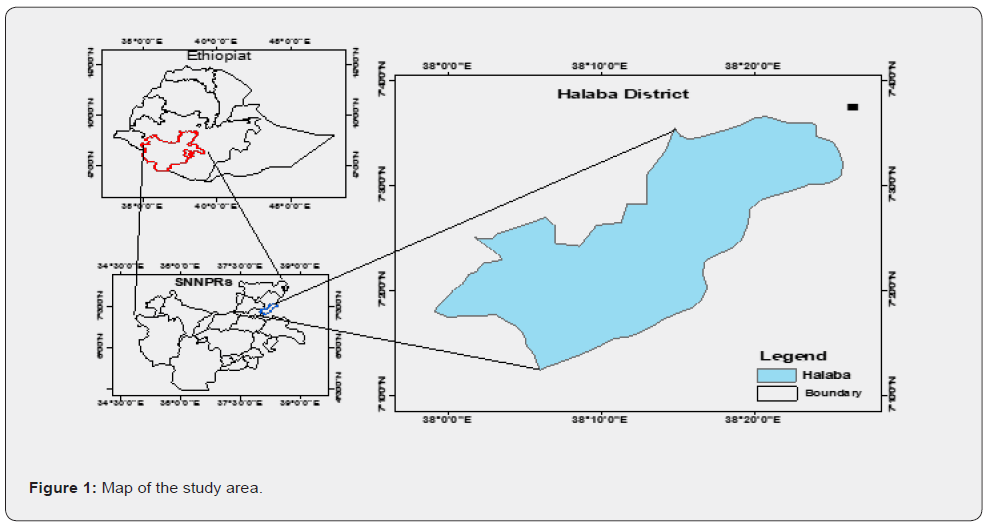
The mean annual rainfall is between 544 and 1271mm, which shows large spatial variability with maximum rainfall as large as 2.34 times the minimum rainfall. The mean monthly minimum and maximum temperatures are 12.8oC and 26.8oC. The climate is characterized as temperate or locally called woyinadega, with two major seasons, Belg (February, March, April, and May) and Kiremt (June, July, August, and September), and irrigation is practiced in some parts of the Bilate river. The economy is largely based on subsistence agriculture in the form of dry land farming and raising livestock. The main cash crops include pepper, maize, teff, sorghum, haricot beans, and wheat. Halaba district is entirely lowland and is especially prone to food insecurity due to erratic rainfall/drought and population density.
Research design
The research design is the conceptual structure within which the research will be conducted. Therefore, in this study, we used a cross-sectional survey to analyze data collected from a sample population at a specific point in time.
Sampling procedure and sample
A two stage sampling technique was employed to select the sample district, kebeles, and household heads. In Ethiopia, the kebele is the smallest administrative unit. In the first stage, the district was selected purposely because it is one of the most vulnerable areas to the adverse impacts of climate variability in Ethiopia. Four kebeles were selected again in consideration of the fact that they are frequently affected by floods and droughts, and as a result, a large number of people are beneficiaries of the safety net program. The selected kebeles were Merab Gortencho, Hantazo, Dalo Laka, and Galato. A total of 200 samples were drawn from the households of the four selected kebeles, which was 2086. Purposive sampling was used to select participants for the Focus Group Discussions (FGDs) and Key Informant Interviews (KII). The four kebeles where the sample size is determined by using a simplified formula provided by Yamane (1967) determine the required sample size at a 95% confidence level, degree of variability = 0.5, and level of precision = 9% (0.09) (Table 1).

Where, n is = sample size; N = population size; and e is = level of precision at 0.05.
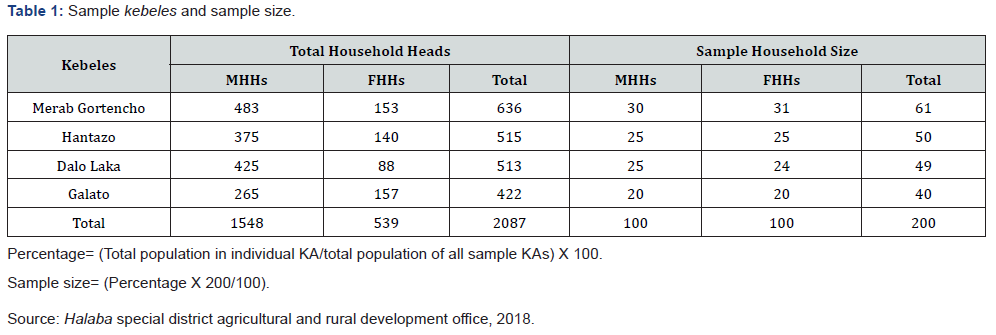
Data types and collection methods
Both qualitative and quantitative data were collected from primary and secondary sources. Primary data were collected from sampled female and male-headed households, key informants, and focus group discussions. The questionnaires were designed in accordance with planned objectives. The open and close-ended questionnaires were translated into the local Amharic language for easy understanding during primary data collection. The questionnaire was pre-tested on each study’s kebele before undertaking the survey. The questionnaires were administered with the help of development agents from local agricultural officers who had been trained before data collection. Collections of household data were collected between September and October 2018. In addition to administering the household-level survey questionnaire, key informant interviews (KIIs) and focus group discussions (FGDs) were conducted for data collection. Secondary data were obtained from the literature, documentation centers, the office of statistics in the respective kebeles, and the national meteorological institutes to consolidate the information obtained during primary data collection and support the results of the study.
Analytical methods
Descriptive analysis
Descriptive statistics such as mean, frequency and percentage were used to visualize and analyze the data.
Econometric analysis
Pearson’s correlations were calculated for relationships among the independent (explanatory) variables. A multinomial logit (MNL) model was applied to explore factors affecting farmers’ use of adaptation strategies to reduce the impact of climate change and variability in the study area. The MNL has been widely employed in climate change adaptation studies [14]. The question is how ceteris paribus changes in the elements of x affect response probabilities, P(Y = j|x), j = 0. 1, 2 . . . J. P(Y = j|x) is known after determining the probabilities for j = 2... J. Because the probabilities must sum to unity, Let _ be a 1 _ K vector with first element unity. Thus, the probability that household i with a characteristic X chooses an adaptation option j is specified as follows [15]:

Where P stands for probability, j stands for adaptation options; x stands for explanatory variables. Bj = k_1 is the coefficient, and j = 1, 2...M. The dependent variables included in the model in this study were adaptation strategies used by MHHs and FHHs farmers in the study area, which were obtained from the survey data collected. These variables included crop diversification, mixed farming, soil and water conservation, income diversification, and irrigation practices. Independent (explanatory) variables were obtained from the survey data (Table 2).

Results and Discussion
Demographic and socioeconomic profiles
The results of the farmers’ socio-economic and demographic characteristics show that of the total 200 farm households interviewed in the districts, both female and male-headed households were represented in the sample population with an equal proportion (i.e., 50% for each) because male-headed data are used as comparisons to explain women’s condition (Table 3). Originally, the plan was to select female-headed households based on their proportion of the total number of household heads in each kebele. Obtaining a sufficient number of households headed by was expected to be difficult. However, during selection of the sample respondents, it was discovered that there were a good number of female-headed households, and it was decided to represent them in an equal proportion to that of male-headed households. In the past, it was difficult to obtain households headed by women in the community. When this husband dies, one of his brothers marries the widow. Due to the intervention of governmental and non-governmental organizations and the existing support for such practices, such practices have somewhat decreased. Moreover, there are emerging efforts in the district that maintain women's interests. According to the focus group discussion participants, local culture permits men to marry more than one wife. An aged male married a very young woman and had children. Then the husband dies because of age and the woman becomes a single mother. Consequently, the number of households headed by women is increasing. This justifies the increased number of female-headed households by focus group discussion participants.
The age range distribution of the respondents showed that 38.5% of the respondents are in the 21-34 age group and 51% are in the 35-60 age groups (Table 3). This implies that the majority (89.5%) of the respondents were at their most productive and reproductive age group, which indicates that they practice high workload due to either having a large number of children or fully participating in different agricultural and non-agricultural activities. Additionally, the farming experience of the household was mostly related to age. This implies that the older the household head, the more reliable the information he would provide on climate change and variability would be. Consistent with the study of Montle and Teweldemedhin (2014), it is stated that the older the farmer, the more experienced and better exposed he or she is to present and past climatic conditions [16].
The total female-headed households, 81 are widowed and 19 are divorced. The male-headed households’ polygamy and marriage account for 37 and 63, respectively (Table 3). According to focus group discussion participants, the local culture permits men to marry more than one wife. An aged male married a very young woman and had children. Then the husband dies because of age and the woman becomes a single mom. Single-headed households expose children to very limited support systems and poverty. Stable married households are less affected by a lack of resources and support networks, irrespective of the income status of the adults involved. Female household heads have been found to exhibit higher rates of poverty than male household heads.
Like other rural parts of Ethiopia, Halaba district is characterized by a low level of education and a high level of illiteracy. From the study population, 79 of the female headed households were not able to read and write, while only 21 of them attended their education. For male-headed households, 31% were not able to read and write; 69% of them attended education. Education helps to anticipate the consequences of climate change and variability and understand the potential benefits of adopting different strategies to tackle the challenges [5,6,17]. The level of educational attainment of female heads of households is lower than that of male heads of households. Females are less likely to have an education than males, and this makes it difficult for female-headed households to understand climate variability and new adaptation options. The possible explanation for the high illiteracy rate among sample women could be a lack of resources to take girls to education and the practice of early marriages that is common in the study population. Moreover, boys' education is often given more priority than that of girls in the community.
The family size of female-headed households was small (1-4), 4, medium (5-9) 54, and large (above 9) 42. For male-headed households, 31 and 69 of them fall within the category of "medium" (5–9 members) and "large" (above 10 members) (Table 3). The mean household sizes of female-headed and male-headed households were 6.32 and 7.57, respectively. This value was also greater than both the average regional and national values reported of 4.8 (SNNPR) and 4.7 (4.9 in rural and 3.8 in urban) (CSA, 2007), respectively. This is largely due to society's polygamous marriages and a lack of awareness about family planning. This indicates there are many dependents in the family and any negative impact of climate change and variability on agriculture might lead to food insecurity in the study area. The incidence of poverty rises with household size. The poverty situation of female-headed households has been found in other countries to worsen with increases in their household size [18].
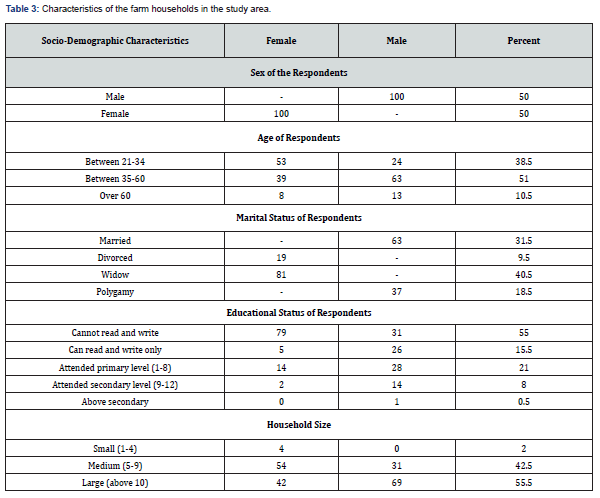
Access and means of ownership of land
The average land holding of the male and female head households is 1.11 and 0.83 hectares. Out of the total female-headed households, 97% accessed land through marriage and only 3% through inheritance, while the male-headed households 86% accessed land by inheritance, 3% through marriage, 7% through land allocation and 4% by leasing from other holders. Thus, in the study area, most people (94.5%) acquired land through marriage and inheritance. According to them, most women in the study area were not collecting land either from government bodies or from their parents. Only few women benefited from inheritance, most of the women acquiring land through marriage when the husband is dying Marriage has been primary means of getting access to land under customary system of tenure in study area. Focus group discussions and interviews with officials confirmed the above reality. This result agrees with the study by Ndaruzaniye [8] the spite of their large role in the agricultural sector worldwide; women are not allowed ownership of land [8]. Compared to men, women farms are smaller and more dispersed and are less likely to hold title, secure tenure, or have the same rights to use, improve, or dispose of land (Table 4).

Livestock holding
The livestock holding size of a household is one indicator of wealth. To assess the livestock holdings of each household in terms of tropical livestock units (TLU), the TLU per household was calculated for the conversion factor used. Female- and male-headed households, on average, own 2.45 and 3.34 TLU, respectively; according to the survey results ownership ranges from 0–11 TLU for female-headed households and 0–16 TLU for male-headed households. This indicates that male-headed households own a large number of livestock compared to female-headed households. Livestock and its products (milk) provide one of the primary sources of household income (in cash). Livestock is considered an asset, which is a security against crop failure. Furthermore, livestock is an asset/wealth for farmers, which means that farmers with a large livestock herd have a better chance of adapting to the effects of climate change and variability. So, in the study area, male-headed households have a better adaptation capacity than female-headed households.
Households’ sources of climatic information
Various studies in developing countries, including Ethiopia, report a strong positive relationship between access to information and the adaptive behavior of farmers. It is reported that access to information through extension increases the likelihood of adapting to climate change [19]. Table 5 shows the different ways in which sample households got information on climate. It shows that farmers get information from development agents (DAs) (39%), radio (17.5%), neighbors or friends (15.5%), the market place (3.5%) and other sources that are vital in this regard. The remaining 21.5% of households, especially women (21%), have no access to information about climate change and variability. In line with this, participants of FGDs also mentioned that observing wind direction is also used by the community as a traditional early warning system to note climate change and variability.
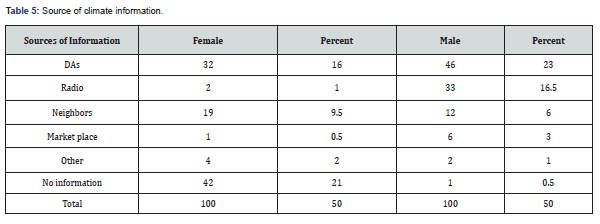
Vulnerability of women to climate change
According to respondents, 42.5% of female and 29% of male respondents accepted that female-headed households were more vulnerable to the effects of climate change and variability than other parts of society. The differential effects were due to differential needs for social activities at the household level and the lack of adaptation capacity. Furthermore, a woman engages in work such as cooking food, cleaning children, collecting firewood and water, and farming to grow crops and earn an income for her family. 7.5% and 18.5% of female and male respondents indicated older members of society and children are much more vulnerable to the effects of climate change (Table 6). This result shows that in the study area, female-headed households are the most vulnerable group in society to the effects of climate change and variability.

Climate change's impact on women
Impacts related to food security
The results of the respondents show that 84% of respondents said they do not get adequate food for their households on a daily basis, and the rest, 16%, said they obtain adequate food. The decreasing of household food security status and the increased number of people in need of food aid are the result of the decreased crop yield production, loss of livestock and other important livelihood assets by the recurrent drought and flood, which in turn is a clear manifestation of the observed changes in the temperature and rainfall. There are various gender implications to the rising threat of food shortages, with both the production and consumption of food being highly gendered. With women making up a large proportion of the farmers in the study area, there are clear gender-specific impacts of climate change on agriculture. In many cases, as rainfall becomes less predictable, making agricultural work more labor-intensive, women will increasingly carry the burden of the additional work and have the least access to necessary inputs. In addition, as climate change increases the likelihood of crop failure, women often face the most negative economic implications, as they have fewer assets on which to rely and limited access to alternative sources of income or livelihood [5]. In all the study kebeles, both women and male participants in focus group discussions have confirmed that food security status at household level is deteriorating and the number of people who need food aid is increasing from time to time (Table 7).

Impacts related to fetching water
According to respondents, the participants of household members in basic household activities of fetching water were 58% women, 18.5% female children; 20% female adults, 2.5% male children, and 0.5% male adults, respectively (Table 8). This result agrees with Women’s Environment and Development Organization, 2018 and the United Nations Statistics Division, 2010 report of 2010. 63% of women in Sub-Saharan Africa collect water in comparison to 11% of men in rural areas, while about 29% of women collect water in comparison to 10% of men in urban areas [20,21]. Focused group discussion also revealed that the situation worsens during drought seasons, with fewer water sources left near the dwelling; women, especially female-headed households, require traveling long distances in order to find fetching water; they have to walk long distances, on average, 4-6km to fetch drinking water. Not only is the burden of work increasing, but women's health, education, privacy, and safety are also affected. They must locate water sources and devise methods for drawing, collecting, transporting, and storing the water. These results also agree with the study in the Lalibela district of Ethiopia, where women reported that during the drought period, time taken to fetch water substantially increased as it would take up to 6 hours a day, while previously it just took 2 hours [5]. Therefore, the problems are much more serious for women than for men, from any perspective.

Impacts related to energy for cooking and lighting
All of the respondents used firewood and dried animal dung as energy sources for cooking and kerosene for lighting. 64.5% of the respondents used both firewood and dried animal dung, and 35.5% used only firewood as a source of power for cooking food (Table 9). There are clear gender dimensions to energy poverty, with the gendered division of household tasks and reproductive activities around cooking and food production meaning that women are often the primary users of household energy. In the study area, according to Halaba District Hydroelectric Power Office (2016), personal communication, only 18 kebeles have access to hydroelectric power and the remaining 61 don’t have access to hydroelectric power. We sampled kebeles, but we don’t have access to hydroelectric power. They are, therefore, the most adversely affected by the lack of electricity, particularly in terms of time spent gathering fuel or the health impacts of relying on traditional wood-burning. The collection of firewood, the preparation of the dung, as well as cooking is basically done by women. This placed a heavy work burden on women. Climate change affects the availability of traditional fuel sources and energy becomes scarcer and more expensive. It is essential that gender dimensions are taken into account in policy making on energy provision to avoid poverty and further exacerbation of gender inequalities. Additionally, this shows two things spontaneously. First, as most of the rural areas in the country power supply are at a poor stage. According to Abid et al. (2018), women are primarily responsible for collecting and carrying fuel wood and forest resources, and walk fairly long distances, which consumes a lot of time, affecting domestic activities, education, and health [5]. In the study area, women travel greater distances to find and collect resources, which consumes more of their time [5,7]. Therefore, especially females who are engaged in preparing food are highly exposed to diseases caused by smoke. The second thing is firewood, which is the main source of energy and is highly related to deforestation. As stated at the FGD, the area covered by forest was large in previous decades, but the proportion of forest is now drastically decreasing due to increasing population and drought. This also puts a heavy work burden on women.

Households' adaptation strategies to climate change and variability
Due to the impact of climate change and variability on agricultural production in particular, farmers are therefore trying to develop their own strategies to cope with and adapt to the impacts of climate change and variability. Based on the information from FGDs conducted in all kebeles, the local communities have their own indigenous mechanisms of adaptation to the problems of climate change and variability. As indicated in Table 10, mixed (crop and livestock) farming is the most preferred climate change adaptation strategy, as indicated by 29.5%. Whereas crop diversification by 24%, income source diversification by 19%, soil and water conservation by 8%, and irrigation by 10.5%. According to Belay [4], an analysis of differences between men-headed and women-headed households showed that male-headed households had better opportunities to practice adaptation strategies than female-headed households [4].
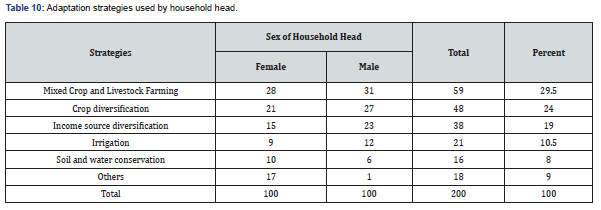
Multinomial logit model outcomes
The multinomial Logit model was also employed to determine the factors that influence farmers' adaptation strategies as well as identify different adaptation strategies of the farmers in response to climate change and variability. The model was run, taking "mixed farming" as the base category against which the remaining outcomes were compared (Table 11 & 12). Besides, the existence of multicollinearity problem was checked using Variance Inflating Factor (VIF) and correlation matrix methods prior to running the final regression analysis. The results of the test indicate the presence of no severe problem of multicollinearity among the explanatory variables. Since, the VIF for each explanatory variable is less than 2 with mean of 1.29.
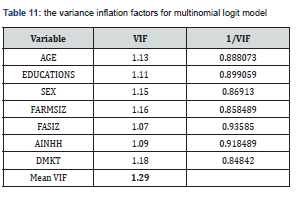
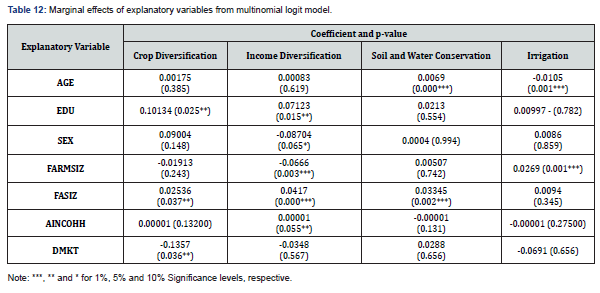
The age of the household head
The age of the household head is one of the significant explanatory variables in which its coefficient has a positive sign. Accordingly, a one-year increase in the age of the household head increased the probability of farmers’ using soil and water conservation adaptation strategies by 0.69 at a 1% significance level. This means that the age of the farmers was positively related to soil and water conservation activities. Because as the age of the household head increases, the person is expected to acquire more experience in weather forecasting, which helps increase the likelihood of practicing different adaptation strategies to combat climate change. This might be attributed to the experience of older farmers in perceiving changes in climatic attributes. This result is in line with the findings of Deressa et al. (2008) and Maddison (2006) [16,17,22]. On the other hand, age has a negative relationship with irrigation adaptation methods. A one-year increase in the age of the household head causes the probability of farmers’ using irrigation practices to decrease by 1.05 at the 10% significance level.
The education level of household heads
Education of households increases the probability of adapting to climate change and variability. A higher level of education is associated with access to information on climate change, improved technologies, and productivity consequences [23]. Our results indicate that education increases the probability of crop diversification and income source diversification as an adaptation method. An increase in the education level of the farmers would result in a 10.1 increase in the probability of crop diversification and a 7.12% increase in income diversification at a 5% significance level. Moreover, almost all of the marginal values of education are positive across all adaptation options, indicating a positive relationship between education and adaptation to climate change.
Sex of households' heads
The result of this study is that female-headed households significantly decreased the probability of income diversification by 6.5 at 10% significance levels. The possible reason for this observation is that in the farming community, men have more information on various management practices than women. They use their experience and information to adopt various adaptation options based on available information on climatic conditions and other factors.
Farm size for a family
Farm size is a significant explanatory variable in this model. That means farmers’ adaptation strategies to climate change are also significantly affected by the amount of farm size that households own. Farm size may also be associated with greater wealth, and it is hypothesized to increase the probability of adaptation to climate change and variability. The results showed that an increase in farm size by 1 hectare decreased the probability of the farmers using income diversification by 6.66% at a 1% significance level. The possible reason for this observation is that most of the time the farmers own large farm sizes and their income depends on agricultural activity. On the other hand, an increase in farm size by 1 hectare, increases the probability of the farmers using irrigation by 2.69% at 1`% % significance levels. In the study area, farmers owning large farm sizes practiced more irrigation activity than farmers owning small farm sizes.
Household family size
The fact that family size has a positive effect on adaptation options; that the large family size has more probability of using crop diversification, income source diversification, and soil and water conservation as adaptation options. An increase in family size by one member of the household would result increase in the probability of crop diversification by 2.54 at a 5% significant level; income diversification by 4.17, and soil and water conservation by 3.34 at a 1% significance level. Because household size can influence adaptation, due to the fact that its association with labor endowment. It is argued that a larger household size enables the adoption of technologies by availing the necessary labor force in one hand and enabling the generation of additional income from extra labor invested in off farm activities. The findings of this study were similar to that of the results of Tagel et al. [24].
Distance to market
In the study area, almost all respondents reported that they traveled more than 5km to reach the market center. An increase in market distance by 1km decreases the probability of income diversification by a factor of 13.57 at a 5% significant level. This can be explained in terms of far distance from the market area decreasing the probability of the farmer to practice different income sources. Hassan and Nhemachena (2008) identified that proximity to the market is an important determinant of adaptation, because the market serves as a means of exchanging information with other farmers [25].
Conclusion
Women are most vulnerable to climate change based on their dependence on natural resources, daily life roles, and socioeconomic status. Based on the findings of this study, the following major conclusions were drawn: Female-headed households were more affected than male-headed households in the study area by the effects of climate change and variability-induced hazards. Results clearly show that there are significant differences in the means of female and male-headed households on major resources such as farm size, livestock holdings, and annual income. Female-headed households are by far more disadvantaged than their male counterparts in terms of possessing these resources. These resources are very crucial for the household to adequately adapt to the perceived impacts of the changes in the climate. Therefore, adaptation strategies adopted by females whenever they are exposed to climate-related hazards are highly dependent on and determined by the limited resources that are at their immediate disposal.
The results from the multinomial logit analysis show that farmers in the study area perceive there is a change in the climate and they are aware of how to deal with it through crop diversification, mixed farming, soil and water conservation, and irrigation practices. Significant explanatory variables that were significant in influencing households when adapting to climate change and variability were: age, education, sex, farm size, family size, annual income, and distance to the market. They have a significant influence on female and male-headed households’ climate change adaptation strategies. In particular, female-headed households significantly decrease the probability of income diversification. The education level of the household head has a positive effect on the probability of farmers using crop diversification, income diversification, soil and water conservation, and irrigation. An increase in the level of education of the household head increases the probability of farmers using crop diversification, income diversification, soil and water conservation and irrigation adaptation methods. But in Halaba district, the educational level of women is very low compared to men. Women constitute nearly half of the rural population and play a vital role in the rural economy. They need to be considered equal partners in the development process. So, the investment in women's education systems and sufficient input supply, which increases women’s adaptation capacity in the rural areas, can be underlined as a policy option in the reduction of the negative effects of climate change. In this regard, a lot of effort is needed from governmental and non-governmental organizations. Additionally, creating opportunities at the national and local level to educate and train women on climate change; stimulating capacity building and technology transfer, and assigning specific resources to secure women’s equal participation In general, more effort is needed from the district government to improve the existing unfair gender relations through community awareness raising, thereby ensuring the wealth inheritance rights of women. The government provides clean energy or hydroelectric power for household lighting or cooking, which will have a positive impact on the health and decrease the work burden of women.
Acknowledgment
First and for most I would like to thank the almighty God for His endless support and blessing throughout my life and for giving me the patience and the courage to accomplish this study timely. My thankfulness is great to Misrak Hassebo (PhD) for his support and constructive advices before and during research work. Am also grateful to all who I have not mentioned that have supported me in one way or another to this point. Finally, I would like to thank the respondents and enumerators for their willingness to provide and collect the necessary data for my research.
References
- IPCC (2014) Climate Change 2007: Mitigation of Climate Change. J Environ Qual 38(2): 837-837.
- S Arora Jonsson (2011) Virtue and vulnerability: Discourses on women, gender and climate change. Glob Environ Chang 21(2): 744-751.
- BS Ngcamu, F Chari (2020) Drought influences on food insecurity in africa: A systematic literature review. Int J Environ Res Public Health 17(16): 5897.
- I Niang et al. (2015) “Africa,” Clim Chang 2014 Impacts, Adapt Vulnerability Part B Reg Asp Work Gr II Contrib to Fifth Assess Rep. Intergov Panel Clim Chang, pp. 1199-1266.
- Z Abid, M Abid, Q Zafar, S Mehmood (2018) Detrimental Effects of Climate Change on Women. Earth Syst Environ 2: 537-551.
- N Rao, ET Lawson, WN Raditloaneng, D Solomon, MN Angula (2019) Gendered vulnerabilities to climate change: insights from the semi-arid regions of Africa and Asia. Climate and Development 11(1): 14-26.
- UN Women Watch (2009) Women, Gender Equality and Climate Change the Need for Gender Sensitive Responses to the Effects of Climate Change.
- C Doss, C Kovarik, A Peterman, A Quisumbing, M Van Den Bold (2015) Gender inequalities in ownership and control of land in Africa: myth and reality.
- MN Ndjiondjop, PW Wambugu, JR Sangare, K Gnikoua (2018) The effects of drought on rice cultivation in sub-Saharan Africa and its mitigation: A review. African J Agric Res 13(25): 1257-1271.
- Adhikari S, Caron L, Steinberger B, Reager JT, Kjeldsen KK, et al. (2018) What drives 20th century polar motion? Earth Planet Sci Lett 502(1): 126-132.
- S Habtezion (2016) Overview of linkages between gender and climate change.
- EL Ampaire, M Acosta, Huyer S, Kigonya R, Muchunguzi P, et al. (2020) Gender in climate change, agriculture, and natural resource policies: insights from East Africa. Clim Change 158(1): 43-60.
- Margaret Alston and Kerri Whittenbury (2013) Research, Action and Policy: Addressing the Gendered Impacts of Climate Change..
- CSA (Central Statistics Agency) (2019) Projected Population of Ethiopia-2011(2019).
- WWH Greene (2012) Econometric analysis. (7th edn), vol. 97.
- MN Uddin, W Bokelmann, ES Dunn (2017) Determinants of Farmers’ Perception of Climate Change: A Case Study from the Coastal Region of Bangladesh. Am J Clim Chang 6(1): 151-165.
- A Amare, B Simane (2017) Determinants of smallholder farmers’ decision to adopt adaptation options to climate change and variability in the Muger Sub-basin of the Upper Blue Nile basin of Ethiopia. Agric Food Secur 6(1): 1-20.
- R Haveman (2015) Understanding Poverty. In: Sheldon H Danziger (Ed.), 30(1).
- A Gadédjisso-Tossou (2015) Understanding Farmers’ Perceptions of and Adaptations to Climate Change and Variability: The Case of the Maritime, Plateau and Savannah Regions of Togo. Agri Africai 6(12): 1441-1454.
- G AffaAffairs. Equality in the midst of climate chanchange at region ’ s machmachinery.
- (2010) United Nations Department of Economic and Social Affairs (UNDESA), The World’s Women 2010.
- A Belay, JW Recha, T Woldeamanuel, JF Morton (2017) Smallholder farmers’ adaptation to climate change and determinants of their adaptation decisions in the Central Rift Valley of Ethiopia. Agric Food Secur 6(1): 24.
- Maddison (2006) The perception of and adaptation to climate change in Africa. CEEPA Discuss. Pap., no. 10.
- T Gebrehiwot, A Van Der Veen (2013) Farm level adaptation to climate change: The case of farmer’s in the ethiopian highlands. Environ Manage 52(1): 29-44.
- RS Chauhan, RB Bhavsar, MM Bhagwat (2008) SEM Studies of the Chars of Flame-Retardant Treated Fabrics. Text Res J 51(7): 477-480.






























